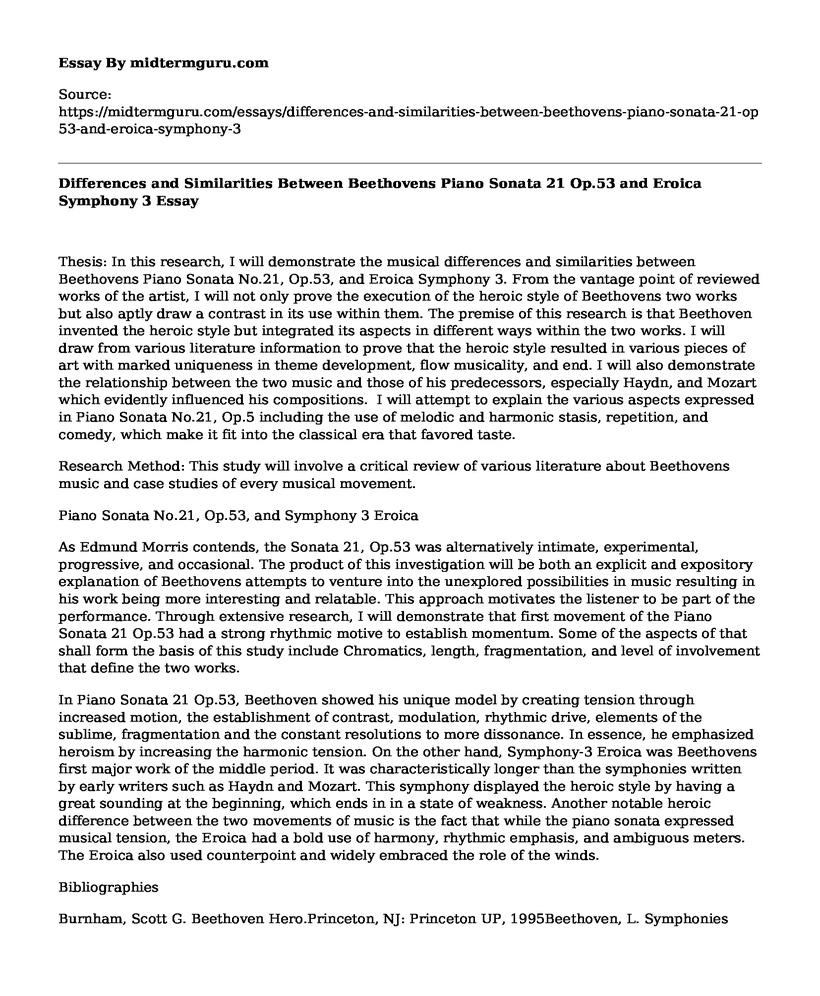Thesis: In this research, I will demonstrate the musical differences and similarities between Beethovens Piano Sonata No.21, Op.53, and Eroica Symphony 3. From the vantage point of reviewed works of the artist, I will not only prove the execution of the heroic style of Beethovens two works but also aptly draw a contrast in its use within them. The premise of this research is that Beethoven invented the heroic style but integrated its aspects in different ways within the two works. I will draw from various literature information to prove that the heroic style resulted in various pieces of art with marked uniqueness in theme development, flow musicality, and end. I will also demonstrate the relationship between the two music and those of his predecessors, especially Haydn, and Mozart which evidently influenced his compositions. I will attempt to explain the various aspects expressed in Piano Sonata No.21, Op.5 including the use of melodic and harmonic stasis, repetition, and comedy, which make it fit into the classical era that favored taste.
Research Method: This study will involve a critical review of various literature about Beethovens music and case studies of every musical movement.
Piano Sonata No.21, Op.53, and Symphony 3 Eroica
As Edmund Morris contends, the Sonata 21, Op.53 was alternatively intimate, experimental, progressive, and occasional. The product of this investigation will be both an explicit and expository explanation of Beethovens attempts to venture into the unexplored possibilities in music resulting in his work being more interesting and relatable. This approach motivates the listener to be part of the performance. Through extensive research, I will demonstrate that first movement of the Piano Sonata 21 Op.53 had a strong rhythmic motive to establish momentum. Some of the aspects of that shall form the basis of this study include Chromatics, length, fragmentation, and level of involvement that define the two works.
In Piano Sonata 21 Op.53, Beethoven showed his unique model by creating tension through increased motion, the establishment of contrast, modulation, rhythmic drive, elements of the sublime, fragmentation and the constant resolutions to more dissonance. In essence, he emphasized heroism by increasing the harmonic tension. On the other hand, Symphony-3 Eroica was Beethovens first major work of the middle period. It was characteristically longer than the symphonies written by early writers such as Haydn and Mozart. This symphony displayed the heroic style by having a great sounding at the beginning, which ends in in a state of weakness. Another notable heroic difference between the two movements of music is the fact that while the piano sonata expressed musical tension, the Eroica had a bold use of harmony, rhythmic emphasis, and ambiguous meters. The Eroica also used counterpoint and widely embraced the role of the winds.
Bibliographies
Burnham, Scott G. Beethoven Hero.Princeton, NJ: Princeton UP, 1995Beethoven, L. Symphonies Nos. 1, 2, 3, and 4. New York: Dover Publications, Inc., 1989. Downs, R. Beethovens New Way in the Eroica. In The Creative World of Beethoven. Edited by Paul Henry Lang. New York W. W. Norton, 1971.
Beethoven - Piano Sonata No.21 in C major, Op.53 (Waldstein) sheet music for Piano. Accessed from https://www.8notes.com/scores/13100.asp
Lockwood, Lewis. Beethoven: The Music and the Life. New York: W. W. Norton & Company, 2003.
Lockwood, Lewis. Beethoven: Studies in the creative process. Harvard Univ Pr, 1992.
Lockwood, Lewis. "Beethoven's Earliest Sketches for the" Eroica" Symphony." The Musical Quarterly 67, no. 4 (1981): 457-478.
Ludwig van Beethoven. Beethoven's Eroica Symphony No. 3 in Eb Major (Eroica) Op. 55. Accessed from http://www.free-scores.com/download-sheet-music.php?pdf=15982
Morris, Edmund. Beethoven: The Universal Composer. New York: Atlas/Harper Collins, 2005.
Sipe, Thomas. Beethoven: Eroica Symphony. Cambridge University Press, 1998.
Solomon, Maynard. "Beethoven's Ninth Symphony: A Search for Order." Nineteenth-century music (1986): 3-23.
Steblin, Rita. "Who Died? The Funeral March in Beethoven's Eroica Symphony." The Musical Quarterly 89, no. 1 (2006): 62-79.
Will, Richard. The characteristic symphony in the age of Haydn and Beethoven. Vol. 7. Cambridge University Press, 2002.
Ludwig van Beethoven. Beethoven's Eroica Symphony No. 3 in Eb Major (Eroica) Op. 55. Accessed from http://www.free-scores.com/download-sheet-music.php?pdf=15982
Cite this page
Differences and Similarities Between Beethovens Piano Sonata 21 Op.53 and Eroica Symphony 3. (2021, Jun 02). Retrieved from https://midtermguru.com/essays/differences-and-similarities-between-beethovens-piano-sonata-21-op53-and-eroica-symphony-3
If you are the original author of this essay and no longer wish to have it published on the midtermguru.com website, please click below to request its removal:
- Essay on the Role of Musicians in Modern Society
- Annotated Bibliography About the Dancer Alvin Ailey
- The Mullbery Tree by Vincent Van Gogh - Critical Essay
- Essay Sample on Music in Africa
- Rock 'N' Roll: The Birth of a Musical Revolution - Essay Sample
- Bernardo Strozzi: The Influential Italian Painter of the 1600s - Research Paper
- Movie Analysis Essay on Titanic







